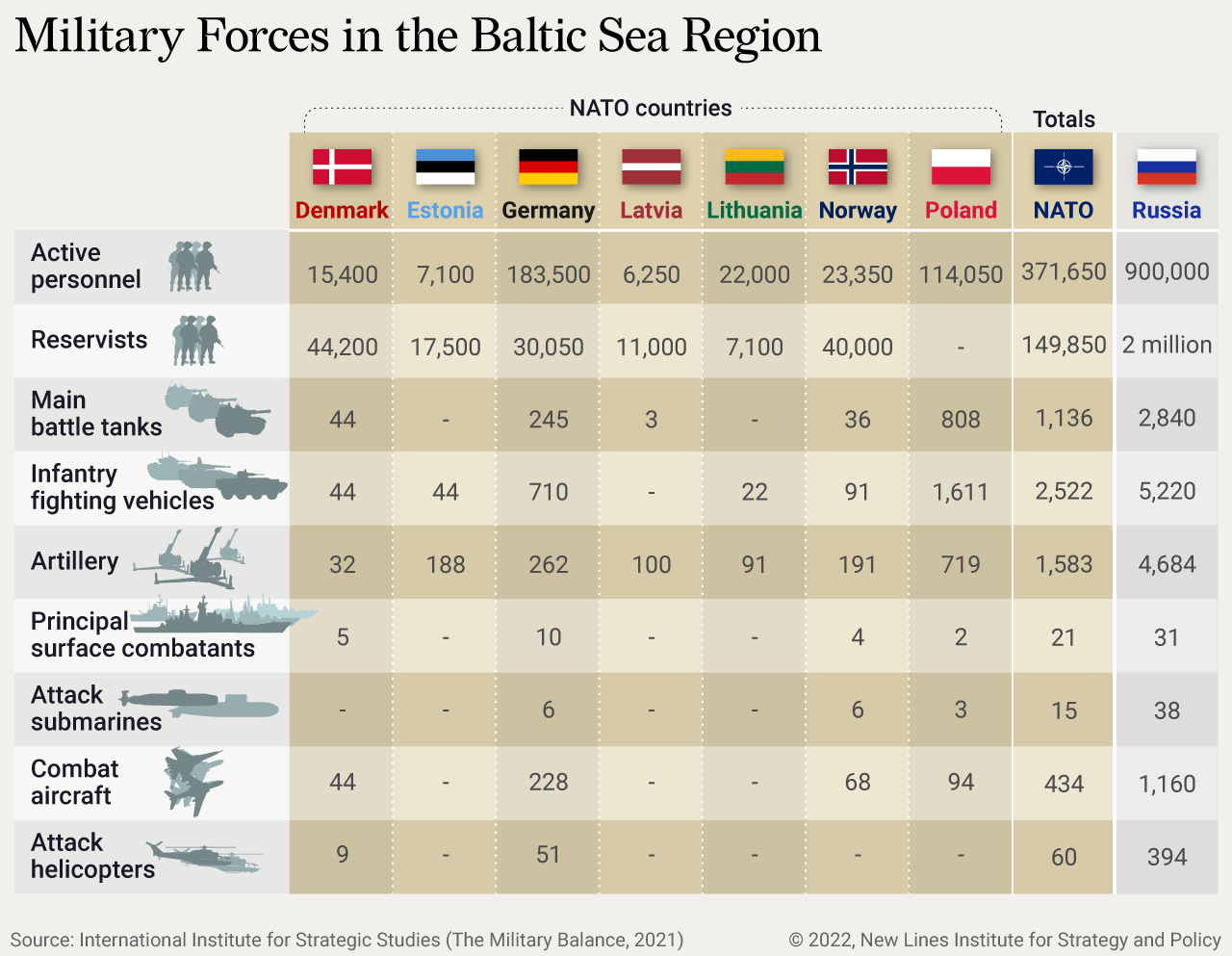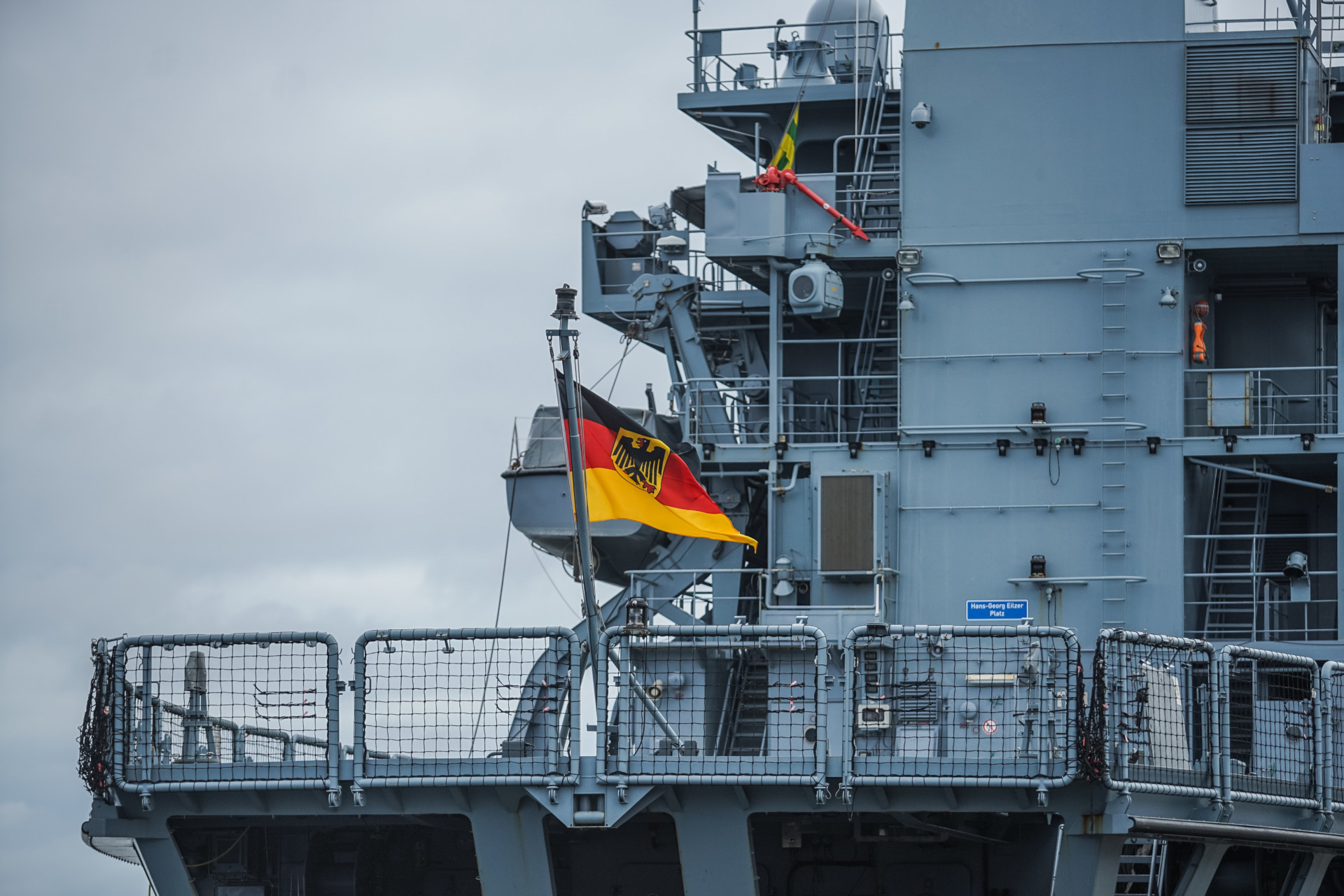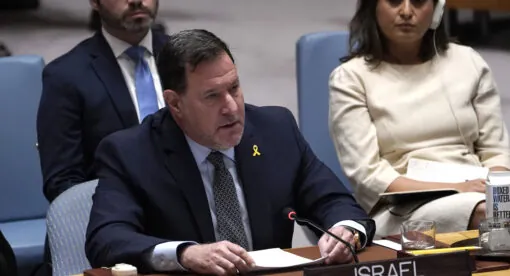The Baltic Sea region is an area where NATO’s greatest concerns are concentrated – from disinformation and destabilization efforts in the gray zone to the general risk of a military conflict. Decisions on collective defense in the Baltics will have global consequences in the 21st century’s great-power competition. Meanwhile, Germany’s new government is on the verge of changing its post-1990 habit of bypassing strategic decisions for the sake of NATO and of European security. Specifically, the new German government could adjust its standpoint regarding Baltic defense. Yet if Germany is about to make such a consequential change, it needs an unyielding U.S. commitment to NATO and European security, which became questionable during the Trump administration. If Germany chooses to take a bigger role in the alliance’s security operations, Berlin will have to prioritize NATO over economic relations with Russia.
The “traffic light” coalition – the Social Democrats, Free Democrats, and Greens – in Berlin is aware of this watershed moment created by the Russian pushback to NATO’s expanding influence so close to Russia’s borders and by the urgent need for coherence among the alliance’s member states. With Russian armed forces mobilizing along the Russian-Ukrainian border and Belarus coordinating a flow of migrants and refugees toward Poland and Central Europe, pressure is building on NATO’s eastern flank.
The Urgency of Germany’s Strategic Decision Making
Following Angela Merkel’s 16-year chancellorship, Germany’s new governing coalition has no grace period for acclimating to international politics. From the global challenges of the COVID-19 pandemic to the increasing great-power competition between NATO and the West on the one hand and Russia, China, and an assortment of actors on the other, the current global environment calls for a realistic Berlin in a leadership role both within and beyond Europe. This situation means that the ruling coalition will find the previous governmental preference of avoiding clear strategic decisions untenable.
Germany’s reluctance to think of itself beyond its economic leadership role has led to a conundrum: Germany is “being doomed to lead Europe” as a reluctant power, with a whole generation of Germans who grew up surrounded by friends without recognizing the need for strategic thinking in international politics or the need for a robust and capable military, and without a single thought of the original purpose of armed forces: the defense of German and allied territory.
This reluctance is clear in Germany’s preference for using sanctions instead of sending soldiers and its anxieties about using military means and adopting a realpolitik foreign policy approach. This makes Germany – the largest and financially and economically strongest European ally, with one of the largest armed forces and the largest naval presence in the Baltic Sea – a country described by analysts as a “reluctant ally” which “has neither the intention nor the ability to be the main security guarantor for the Baltic Sea region.”
Yet Germany’s actions in the Baltics do not correspond with the image of a “reluctant ally.” Germany is the only continental European nation to lead one of NATO’s enhanced forward presence battlegroups, in Lithuania. Furthermore, Germany is involved directly in NATO’s Baltic Air Policing, is a co-founding nation of the Multinational Corps Northeast, and will take the lead of NATO’s Very High Readiness Joint Task Force as part of the NATO Response Force for the third time in 2023.
Germany has taken the initiative notably in the maritime domain. Almost immediately following the Russian annexation of Crimea and the corresponding war in Ukraine, starting in 2014, the German navy initiated the Baltic Commanders Conference, opening a consultation forum for all allied and partner navies in the Baltic Sea region. It also created the German Maritime Forces Staff in 2019, consolidating and optimizing its previous staff structure, and developed the Baltic Maritime Component Command, which will be offered as a naval headquarters for NATO at its northern flank. The German navy also intends to assume NATO’s projected Baltic Maritime Coordination Function.
However, the challenges of the Baltics could do more than give Berlin a specific area to help protect: The tensions in the Baltic Sea region could be the impetus Germany needs to change its overall position on military involvements and adopt a more strategic imperative in its foreign and security policies. Germany could take a leading role in the Baltics and beyond by:
- increasing its defense budget significantly and complying with NATO’s goal of each member country devoting 2% of its GDP to defense spending, which NATO members in 2014 agreed to achieve by 2024;
- emphasizing its allied defense commitments and demonstrating that its interests are not solely oriented toward economic benefits but are in line with the security and collective defense of the alliance and its members; and
- strengthening the regional security architecture in the Baltic Sea region and becoming the European leader its partners have waited so long for it to become.
The Baltic Sea region has, for about 15 years, been a cauldron of NATO-Russian tensions. Russia’s actions in the Baltics – including almost daily intrusions into allied airspace as well as provocations and incidents that fall below NATO’s Article 5 threshold or an open military conflict with NATO and its partners – pose a military threat to the alliance and its peripheral member states. The Baltic Sea region has accounted “for close to 40 percent of all U.S./NATO-Russian encounters” since 2013. The key issues in the region mirror those that NATO must deal with internally: differing individual threat assessments, the dichotomy of political evaluations and economic entanglements, and the question of sufficient defense spending as well as military capabilities. Altogether, the Baltic Sea region embodies a focal point of challenges and requirements, making it a kind of NATO in miniature, with “almost all of the alliance’s needs, issues and dynamics” present. Eventually, nothing less than NATO’s raison d’être will be at stake in the region.
Moreover, the increasing tensions along the Russian-Ukrainian border make the situation even more crucial for the alliance. The latest claims by Moscow, including the demand to remove any NATO forces from the countries that joined the alliance since 1997, are trying to undermine the alliance’s core – collective defense – by using Machtpolitik and the threat of pure military power to pressure NATO on its eastern flank. However, those attempts might have the unintended effect of bringing Germany, the U.S., and their allies even closer together regarding Baltic defense.
The Baltic Sea Region’s Security Architecture
The security architecture in the Baltics involves a multitude of states and a framework that is political, strategic, and operational. It is defined predominantly by the Russian Federation on the one hand, and two main institutions – NATO and the European Union – on the other. NATO’s collective defense commitment in particular emphasizes the transatlantic involvement in the Baltic Sea region.

The 2014 war in Ukraine demonstrated that Moscow is both able and willing to act against sovereign states in its immediate periphery, using both subversive means and military force and/or intimidation. Some analyses and war games that acknowledged the three Baltic states as an allied Achilles heel, barely able to defend against a potential Russian military intervention, became popular. A closer look shows the actual dilemma for the alliance: Not only does Russia have higher investments in defense and more armed forces overall, it also has the advantage of established military structures and deployments within its Western Military District. Therefore, Moscow can very quickly mobilize forces.
NATO, on the other hand, has military forces spread across member states, and only a fraction of those forces is actually combat ready and quickly deployable. In addition, the NATO-Russia Founding Act prohibits a permanent stationing of NATO forces on its Eastern European members’ soil. Thus, only a sparse NATO force is present in Poland and the Baltics on a rotational basis. This leads to the conclusion that, “despite having much larger armed forces and defense expenditures, NATO still has difficulty in assembling the same numbers of ground forces as Russia.”

The ability to gather military power relates to the assurance of NATO’s collective defense. The alliance has to be able to defend even its most peripheral member states, or, as mentioned above, its raison d’être would be invalid. The importance of this ability is evident in the location of NATO’s sea lines of communication for additional forces – particularly follow-on forces from the U.S. These lines do not end in Antwerp or Bremerhaven, as they did during the Cold War, but in Tallinn, Klaipeda, and Riga. During a potential conflict, allied coordination and air and naval forces would have to cope with several layers of scaled Russian defense networks, including sophisticated anti-access/area denial capabilities. Besides the force imbalance, the difficulty for NATO reinforcements lies in Russia’s concerted defense capabilities spread around its Western Military District, in the Kaliningrad Oblast and, increasingly, also in Belarus – a strategic factor that NATO and the West considered almost “non-existent” until recently.
These factors challenge NATO forces’ freedom to maneuver within the Baltic region during a potential conflict. Moreover, Russia could use its military assets around the Baltics to quickly form bridgeheads for operations in the region. If Moscow were to follow through on its threat to station more intermediate-range nuclear ballistic missiles on Russia’s European soil, the security framework of the Baltic region and all of Europe would be affected.
Eventually, the geopolitical flashpoint in the Baltics will show that “what happens in the Baltic Sea does not stay in the Baltic Sea” but has enormous significance for European and global security policy. Russian demands that NATO relocate forces from its eastern members’ territories and reject any additional member in Eastern Europe might be considered a regional issue, especially considering military buildup on the Russian-Ukrainian border. Yet such concessions would have a global impact, since a defense alliance cannot promise an outsider that it will not defend its member states when they are under pressure. It would mean that, instead of sovereignty and territorial integrity, power politics and military pressure are able to define European security once more.

Overcoming Germany’s Military Problems
Though Berlin has demonstrated a willingness to get involved in security in the Baltic Sea region, Germany’s security and defense policies leave plenty of room for criticism. The 1990s left Germany with military equipment in poor condition and armed forces of dubious readiness, and it has taken time to overcome those issues. For instance, in 2015 and 2019, as the German army took over NATO’s Very High Readiness Joint Task Force for the first and second times, it grabbed headlines by gathering equipment from all over the armed forces, from main battle tanks to body armor, and using painted broomsticks as machine guns during a NATO exercise. For the most part, the German armed forces’ equipment and readiness has improved, but the brigade nominated to lead the task force for this third round – the Panzergrenadierbrigade 37 – will still depend on its comrades’ materiel. Procurement, equipment, readiness, and personnel remain critical as German forces regain their abilities to carry out high-intensity warfighting and to defend allied territory – two of the current main requirements of the Baltic Sea region.
Even though Germany’s defense budget has grown continuously since 2014, in relation to Germany’s economic power and regarding European and Baltic security, improvements are essential. In fact, German Chancellor Olaf Scholz (of the Social Democrats) promised that the German defense budget will grow within the country’s means. But even though the German coalition agreement includes Scholz’s declaration that Germany will meet NATO’s spending goals, the agreement does not appear to include a passage that explicitly suggests a growing defense budget. Instead, the Social Democrats, the Greens, and the Free Democrats intend to take a “3D approach” of diplomacy, development, and defense with their foreign and security policies, aiming to spend 3% of Germany’s GDP altogether. This approach corresponds with the idea of an “all of a piece foreign policy,” as stated in the coalition agreement, and eventually could be used to boost defense spending to NATO’s declared 2% target.

The coalition’s agreement does, however, include the goals of finalizing two yearlong German procurement controversies. First, after many years of circular debate within the German government, the coalition has decided to arm drones (Israeli Heron TPs) for the German armed forces. Second, the government will decide on which plane will succeed the multirole combat aircraft the Panavia PA200 Tornado. This decision is of particular importance because the German air force would use the aircraft to fulfill its part of NATO’s nuclear sharing and thus contribute to NATO’s nuclear deterrence posture – something specifically of interest to the security of the Baltic Sea region. The current alternatives include the Eurofighter Typhoon, the McDonnell Douglas F/A-18 Hornet, and the Lockheed Martin F-35.
The Nord Stream Factor
For now, Russia cannot be expected to change its use of intimidation and subversive efforts against its neighbor states. Therefore, Western allies and their partners need to take a united approach in deterring any military conflict or escalation in the region. Yet if Berlin prefers to defend its bilateral economic ties with Moscow – as illustrated by the Nord Stream 2 natural gas pipeline – Germany’s allies are wondering whether it would be ready to fulfill its allied defense commitments if called upon. Given Germany’s participation in many security initiatives within the Baltic Sea region and as a NATO member such doubts are problematic.
German Defense Minister Christine Lambrecht’s first trip abroad took her to the German-led NATO enhanced foreign presence mission in Lithuania. The visit sent an important message regarding the region’s relevance and Germany’s defense commitments. During her first speech at the Bundestag, Lambrecht accentuated the promise to increase Germany’s defense budget, to address the military equipment issues, and to modernize the German armed forces’ procurement process. Moreover, during German Foreign Minister Annalena Baerbock’s first visit to Washington, she and U.S. Secretary of State Antony Blinken expressed a unified and clear attitude toward Russia. Put together, Lambrecht and Baerbock’s comments and Scholz’s announcements about military spending and improvements show that leading German politicians have begun to form a more coherent line regarding the German armed forces, Russia, and Baltic defense.
Notably, Scholz, who underlined that “all options are on the table” regarding the possibility of sanctions following a potential Russian aggression, helped leading Social Democrats to correct their course: Lambrecht, who initially wanted to keep the Nord Stream 2 pipeline out of discussions about the Russia-Ukraine conflict, eventually excluded further economic engagements like Nord Stream 2 if Russia initiated a war “in the middle of Europe.”
If the German ruling coalition wishes to apply its declared “all of a piece foreign policy,” it should acknowledge the strategic nature of Baltic defense. It is also crucial for the ruling coalition to recognize that Germany’s economic and political resources give it the ability and opportunity to strengthen the Western defense and deterrence approach in the Baltic Sea region effectively. To erase doubts about its commitment to NATO, the new German government needs to revise and adapt its current hedging strategy regarding Russia.
In today’s great-power competition, the ongoing war and imminent escalation in Ukraine, the defense of the Baltics, and the Nord Stream gas pipelines might be seen as separate issues, but together, they have strategic influence regionally and globally. Germany’s ties to Russia – particularly the Nord Stream pipelines – frustrate a unified allied reaction in the Baltics and Ukraine (although Ukraine is not a NATO member and no defense commitment is in place, Germany and the West have an interest in maintaining its sovereignty). As the economic heavyweight of Europe, Germany should leverage its capabilities in an allied, transatlantic context. If it intends to continue its economic connection with Russia, however – to keep up bilateral communication, for instance – Germany will need to emphasize that Moscow is not the only one capable of articulating red lines.
Admittedly, Germany’s options are limited. As with any other nation, it has to consider numerous factors, including domestic politics and German and European dependence on Russian gas. The current situation should illustrate that such immoderate dependence is not practical, and that modern interconnectivity cannot be separated from certain policy areas.
The U.S. is in a position to nudge Berlin toward an understanding of what Germany’s strategic position and capabilities, along with its ties to Russia, mean beyond domestic politics. German leaders have highlighted the importance of Washington in Berlin’s potential decision to take a greater role in European defense. “The German-American friendship and NATO are the indispensable foundation of our security,” Scholz said during his first government declaration in the Bundestag on Dec. 15, 2021. By emphasizing the relevance of Berlin’s relationship with Moscow from the NATO allies’ perspective, the U.S. could help Germany understand the international strategic reality.
Recommendations
The Biden administration has more influence and credibility, and a completely different reputation, in Germany than its predecessor did. It can emphasize Germany’s role for Baltic defense and, even more, for European security within the contemporary great power competition. Nevertheless, U.S. policymakers are advised to argue from an allied perspective rather than a bilateral one. To approach the Nord Stream 2 issue by sanctioning German companies involved in the project could unintentionally push the narrative that the U.S. is principally interested in selling its own liquefied natural gas in Europe.
To secure Baltic defense, NATO needs to present a strong and united security approach. Only if this bond is robust can the alliance expand its defense and deterrence posture. Yet NATO efforts in Eastern Europe are limited due to the NATO-Russia Founding Act as well as the fact that a limitless stationing of NATO forces in the Baltic Sea region would only fuel a Russian security dilemma. Thus, a symmetric defense approach in relation to the force level is neither possible nor logical. Instead, NATO should seek to expand a broad deterrence-by-punishment approach – including economic and financial consequences as possibilities – and explain that it would outplay any aggression with its own global strengths. This could help avoid the creation or escalation of a security dilemma for Russia and create a comprehensive deterrence posture with combined elements of denial and punishment.
Germany and the U.S. both are crucial in that regard. On the one hand, the U.S. remains the main security guarantor in Europe. On the other, Germany could step up regarding European and Baltic defense, take more responsibility with its European partners, and address the challenges together with the U.S. in a more even-tempered manner. Above all, its economic, commercial, and political potential could strengthen a broad allied deterrence approach significantly. After all, Germany has the support from its European and transatlantic allies to fulfill those expectations. Its new political leadership just needs to make use of that support, and the U.S. is in the position to encourage its transatlantic friends wisely.
Julian Pawlak is a research associate at the Helmut Schmidt University/University of the Federal Armed Forces Hamburg and the German Institute for Defence and Strategic Studies (GIDS). His research covers NATO’s Northern Flank and the Baltic Sea region, and can be read, inter alia, in his recently co-edited volume From the North Atlantic to the South China Sea. Allied Maritime Strategy in the 21st Century. You can reach Julian via @jupawlak on twitter.
Disclaimer: This analysis represents the author’s views and not necessarily the of the University of the Federal Armed Forces, the German Institute for Defence and Strategic Studies nor the German Ministry of Defence.






